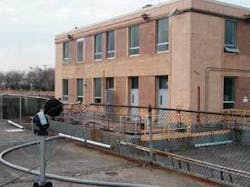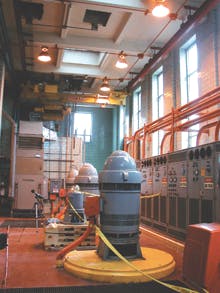Can Water Treatment Plants be Quiet? Simple Measures Can Limit Noise Complaints
by Lewis S. Goodfriend and Anthony R. Bontomase
Noise does not have to identify water pumping and treatment plants as bad neighbors. Besides odor and lighting at these facilities, noise may become a major issue, especially as plants are upgraded and expanded and as residential development approaches existing plants.
Almost every plant improvement requires increased pump, compressor and fan capacity. Each of these improvements adds another noise source, leading to higher noise levels unless noise control measures are installed. While increasing facility capacity using modern high efficiency fans, motors and VFD drives may cause the ambient noise environment to rise only slightly, new equipment also can add new “tones” to the ambient sound. While a small increase in total noise levels may not be noticed by most people, the presence of discrete tones will be noticed and can be annoying.
In cases where two similar devices are installed or replaced, the resulting equipment tones may vary slightly and create a tone which causes an audible “beating” or pulsating effect. While barely audible, these tones can increase annoyance as much as a ten-fold increase in total sound energy - and can be perceived as a doubling of the loudness. In some cases, the tonal sounds seem to change in loudness and character as the neighboring homeowner walks around inside or outside their house, but the tones never go away.
After the first encounter with their new soundscape, homeowners in the plant neighborhood often call the plant office, the police and the mayor to complain of the “intolerable” noise - even though the number of decibels has changed only slightly and may meet state and municipal noise regulations.
Is there a solution to this usually unforeseen and too often unpleasant situation? The answer is absolutely yes.
Noise Control
Effective noise control engineering can provide a wide range of solutions beginning with
effective use of the site, careful equipment selection and good noise control design. Some of these more effective solutions include:
• Equipment Location: Locating the noisiest equipment as far from neighboring residential properties is the first step. If the new equipment is part of an upgrade, it may not be as easy to locate it very far from the neighbors, but an assessment should be made of the noise impact with the equipment in alternate locations that might take advantage of distance or physical noise barriers. While property lines are usually the primary concern for noise regulation compliance, the locations of any residences and their respective elevations should not be overlooked. A physical barrier to reduce noise is only effective if it interrupts line of sight. Although a barrier may block line of sight to the property line, there may be clear path between the noise source and the upper story window of a residence.
• Facility Ventilation: Plant enclosures are usually fabricated of materials that can reduce noise levels at neighboring locations, but too often these buildings have wall mounted fans and ventilation louvers that allow noise to radiate from the building to the neighboring properties. A wide range of relatively inexpensive noise control equipment is available to reduce noise propagating through these openings. Acoustical louvers and HVAC duct silencers can provide substantial noise reductions. On occasion, inadequate ventilation leads to doors being left open, thereby negating the effectiveness of noise control systems. Keeping the doors closed and including noise control devices in adequately sized ventilation openings will reduce the noise escaping the building or enclosure.
• Emergency Generators: Emergency power is relatively common at most pump stations and water treatment facilities. The noise from emergency generators and associated equipment (remote radiators and load cells) should not be overlooked due to their relatively infrequent operation. Generator equipment can often create more noise than all of a facility’s other equipment combined. Acoustically rated enclosures are readily available from generator manufacturers or third party vendors. The noise from an emergency generator installed within an existing building can also be effectively controlled by using an appropriate exhaust muffler and treating air ventilation openings with acoustical louvers or duct silencers.
• Variable Frequency Drives (VFD): Technology is now available to adjust the speed of most rotating devices based upon the required load. Modern fans, electric motors, and pumps can all be outfitted with a variable frequency drive. Data has shown that operating an electric motor at 70% of capacity can reduce the sound pressure by 75%. This translates into a significant reduction in sound level of approximately 6 decibels. In some cases effective noise control may be achieved by slightly “over-sizing” a device and using a variable frequency drive to permit operation below full speed except when higher flow rates are required. In addition, “high efficiency” motors and other equipment will often produce less noise than standard efficiency equivalents since there is less “waste” energy available to generate noise.
• Acoustical Data: Today most equipment manufacturers can provide sound level data on their equipment. Most responsible manufacturers will be able to provide sound power data by octave bands. This permits the acoustical engineer to assess the propagation and isolation of sound from the machinery through fields, woods and over barriers in order to evaluate the impact on residential neighbors. It is best to complete this detailed assessment in the design phase of a project and to allow for appropriate noise control recommendations to be developed.
Noise Evaluation
Completing a noise evaluation for an equipment upgrade or a new facility installation of almost any kind generally involves four main tasks.
1. Visit the site to perform acoustical measurements to document the existing noise environment.
While longer duration noise monitoring may be appropriate, this task may not require a significant amount of time. Representative data often can be acquired with the appropriate equipment in less than an hour.
2. Evaluate the expected sound levels from proposed equipment at the nearest property lines or receivers using manufacturer supplied data for equipment.
Many commercially available sound analysis or noise modeling software packages are available for use by anyone willing to learn a new computer program. However, an inexperienced user can unwittingly acquire inaccurate results based on incorrect parameter settings. An experienced acoustical engineer is better equipped to use these “black box” type prediction programs or his own proprietary acoustical models so that the results are accurate and the noise control is appropriate and not over or under designed.
3. Compare the expected sound levels with the applicable limits of the regulations and the existing acoustical environment.
Meeting the required noise limits provided by a governing body is almost always the first means of evaluation so that legal issues are addressed. However, in many instances, the applicable noise regulations may be subjective and simply prohibit loud, disturbing noise which adversely affects the health and wellbeing of surrounding neighbors. In such cases, visiting the site and performing acoustical measurements to characterize the existing noise environment is the only means to evaluate compliance with the regulations or assess the acoustical impact on neighbors.
4. Develop noise control recommendations to meet the regulation requirements or site acoustical design goals.
This is where your acoustical engineer earns his or her pay and where communication with other engineers or architects is necessary. There are almost always several ways to reduce the noise at a location, from a specific noise source. Some noise control options may cost more in materials but be cheaper to implement and operate, or vice versa. Every noise control device or technique will have some impact on the design or operation of a piece of equipment or system.
About the Authors:
Lewis S. Goodfriend, P.E., is the founder of Lewis S. Goodfriend & Associates (LSG&A) and has over 55 years experience in the field of acoustics, vibration and noise control. He is a Fellow of the Acoustical Society of America and a member and past president of Institute of Noise Control Engineering. Anthony R. Bontomase has over 7 years experience in acoustical consulting and has worked on projects ranging from environmental noise evaluations to interior building acoustics and noise control. As project manager, he handles the majority of the firm’s environmental and industrial noise and vibration projects and has worked with architects, engineers and owners to identify, evaluate and develop feasible noise control solutions. LSG&A has been involved with the acoustical design and evaluation of numerous water treatment facilities and pumping stations over that last several decades. For more information, visit HYPERLINK “http://www.lsga.com” www.lsga.com.



